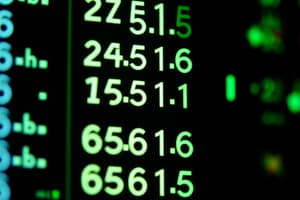Podcast
Questions and Answers
Which protocol is used for connectivity verification in both IPv4 and IPv6?
Which protocol is used for connectivity verification in both IPv4 and IPv6?
- TCP
- ICMPv4
- ICMPv6 (correct)
- UDP
Which type of ICMP message is used for messaging between an IPv6 router and an IPv6 device?
Which type of ICMP message is used for messaging between an IPv6 router and an IPv6 device?
- Router Advertisement (RA)
- Neighbor Advertisement (NA)
- Router Solicitation (RS) (correct)
- Neighbor Solicitation (NS)
What is the purpose of Duplicate Address Detection (DAD)?
What is the purpose of Duplicate Address Detection (DAD)?
- Verifying the path using traceroute
- Confirming the host destination or service unreachable
- Testing connectivity to the local LAN
- Checking for duplicate IPv6 addresses (correct)
Which type of IPv4 address is used for communication from one host to all the hosts in the network?
Which type of IPv4 address is used for communication from one host to all the hosts in the network?
Which type of IPv4 address is used for communication from one host to a selected group of hosts in the same or different network?
Which type of IPv4 address is used for communication from one host to a selected group of hosts in the same or different network?
Which type of IPv4 address is not routed over the Internet?
Which type of IPv4 address is not routed over the Internet?
Which type of IPv6 address is used to communicate with other IPv6 enabled devices on the same link?
Which type of IPv6 address is used to communicate with other IPv6 enabled devices on the same link?
Which numbering systems can be converted between when discussing IPv4 addresses?
Which numbering systems can be converted between when discussing IPv4 addresses?
What are the characteristics and uses of unicast, broadcast, and multicast IPv4 addresses?
What are the characteristics and uses of unicast, broadcast, and multicast IPv4 addresses?
What are the types of IPv6 network addresses?
What are the types of IPv6 network addresses?
Which type of subnetting uses address bits to separate network from hosts and allows for much more flexibility?
Which type of subnetting uses address bits to separate network from hosts and allows for much more flexibility?
What is the formula to calculate the number of subnets when subnetting an IPv4 network?
What is the formula to calculate the number of subnets when subnetting an IPv4 network?
If a subnet mask of /25 is applied to the address 192.168.10.0, how many hosts are there in each subnet?
If a subnet mask of /25 is applied to the address 192.168.10.0, how many hosts are there in each subnet?
Which subnet mask creates four equal subnets, each with 62 hosts?
Which subnet mask creates four equal subnets, each with 62 hosts?
What is the formula to calculate the number of hosts in a subnet?
What is the formula to calculate the number of hosts in a subnet?
Which subnet mask creates 8 networks with 30 hosts in each network?
Which subnet mask creates 8 networks with 30 hosts in each network?
What is the subnet mask that creates a network with 2 hosts in each network?
What is the subnet mask that creates a network with 2 hosts in each network?
Which type of subnetting uses octet boundaries to separate network from hosts in an IPv4 network?
Which type of subnetting uses octet boundaries to separate network from hosts in an IPv4 network?
If a subnet mask of /26 is applied to the address 192.168.10.0, how many hosts are there in each subnet?
If a subnet mask of /26 is applied to the address 192.168.10.0, how many hosts are there in each subnet?
What is the formula to calculate the number of subnets when subnetting an IPv4 network?
What is the formula to calculate the number of subnets when subnetting an IPv4 network?
Which subnet mask creates 64 networks with 1022 hosts in each network?
Which subnet mask creates 64 networks with 1022 hosts in each network?
What is the formula to calculate the number of hosts in a subnet?
What is the formula to calculate the number of hosts in a subnet?
Which subnet mask creates 8 networks with 30 hosts in each network?
Which subnet mask creates 8 networks with 30 hosts in each network?
If a subnet mask of /25 is applied to the address 192.168.10.0, how many hosts are there in each subnet?
If a subnet mask of /25 is applied to the address 192.168.10.0, how many hosts are there in each subnet?
Flashcards are hidden until you start studying
Study Notes
Connectivity Verification
- ICMP (Internet Control Message Protocol) is used for connectivity verification in both IPv4 and IPv6.
ICMP Messaging
- ICMPv6 Neighbor Solicitation message is used for messaging between an IPv6 router and an IPv6 device.
Duplicate Address Detection
- Duplicate Address Detection (DAD) is used to verify the uniqueness of IPv6 addresses on a network.
IPv4 Address Types
- Broadcast IPv4 address is used for communication from one host to all hosts in the network.
- Multicast IPv4 address is used for communication from one host to a selected group of hosts in the same or different network.
- Private IPv4 address is not routed over the Internet.
IPv6 Address Types
- Link-local IPv6 address is used to communicate with other IPv6 enabled devices on the same link.
Numbering Systems
- IPv4 addresses can be converted between decimal, binary, and hexadecimal numbering systems.
IPv4 Address Characteristics
- Unicast IPv4 address is used for one-to-one communication between devices.
- Broadcast IPv4 address is used for one-to-all communication between devices.
- Multicast IPv4 address is used for one-to-many communication between devices.
IPv6 Network Addresses
- There are three types of IPv6 network addresses: unicast, multicast, and anycast.
Subnetting
- Variable Length Subnet Masks (VLSM) use address bits to separate network from hosts, allowing for more flexibility.
Subnet Calculation
- The formula to calculate the number of subnets is 2^(number of borrowed bits).
- The formula to calculate the number of hosts in a subnet is 2^(32 - subnet mask) - 2.
Subnet Examples
- A subnet mask of /25 applied to the address 192.168.10.0 creates 2 subnets with 126 hosts in each subnet.
- A subnet mask of /26 applied to the address 192.168.10.0 creates 4 subnets with 62 hosts in each subnet.
- A subnet mask of /27 applied to the address 192.168.10.0 creates 8 subnets with 30 hosts in each subnet.
- A subnet mask of /30 applied to the address 192.168.10.0 creates 64 networks with 2 hosts in each network.
- A subnet mask of /22 applied to the address 192.168.10.0 creates 4 networks with 1022 hosts in each network.
Fixed-Length Subnet Masks (FLSM)
- FLSM uses octet boundaries to separate network from hosts in an IPv4 network.
Studying That Suits You
Use AI to generate personalized quizzes and flashcards to suit your learning preferences.




